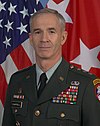United States Army Space and Missile Defense Command
Military unit From Wikipedia, the free encyclopedia
The United States Army Space and Missile Defense Command (USASMDC) is the Army Service Component Command (ASCC) for United States Strategic Command and United States Space Command. It was established in 1985 as the Army Strategic Defense Command, responsible for ballistic missile defense. In 1992, it merged with Army Space Command to become Army Space and Strategic Defense Command. In 1997, it became an Army Major Command and was redesignated Army Space and Missile Defense Command.[1]
| Space and Missile Defense Command | |
|---|---|
 Shoulder Sleeve Insignia | |
| Active | 1 October 1997 – present |
| Country | United States |
| Branch | United States Army |
| Part of | United States Space Command United States Strategic Command |
| Headquarters | Redstone Arsenal, Alabama, U.S. |
| Website | www |
| Commanders | |
| Commanding General | LTG Sean A. Gainey |
| Deputy Commanding General for Operations | COL John L. Dawber |
| Command Sergeant Major | CSM John W. Foley |
| Insignia | |
| Distinctive Unit Insignia |  |
Army Space and Missile Defense Command is responsible for developing and providing the Army with space, missile defense and high altitude capabilities. It consists of two operational elements: the 100th Missile Defense Brigade and the 1st Space Brigade.[2] The commander of Army Space and Missile Defense Command also serves as the commander of United States Space Command's Joint Functional Component Command for Integrated Missile Defense.
Following the Space Force's establishment, the Army's continued involvement with space has become controversial, with multiple proposals and reports advocating for the Space Force to absorb the Army's remaining space forces, as it did with the Navy's space forces, or even Space and Missile Defense Command as a whole.[3][4][5][6] The Space Force has absorbed the Army's satellite communications mission and the Joint Tactical Ground Stations, while the Army maintains the 100th Missile Defense Brigade and a downsized 1st Space Brigade. The Army is attempting to redefine its role in space operations, focused on integrating and interdicting space capabilities for land forces.[7]
Structure
The SMDC is made up of several components, Active Army and full-time Army National Guard, due to the 24-hour a day, 7-day a week, 365-day a year nature of SMDC's mission:[8]
| Name | Mission | Headquarters | |
|---|---|---|---|
| 100th Missile Defense Brigade (100 MDB) | Operates the ground-based midcourse defense system[9] | Schriever Space Force Base, Colorado | |
| 1st Space Brigade | Provide trained and ready space forces to conduct continuous global space force enhancement, space support, space control and special missions[10] | Colorado Springs, Colorado | |
| Space and Missile Defense Center of Excellence | Builds and enables space and missile defense forces responsive to warfighter needs[11] | Colorado Springs, Colorado | |
| Technical Center | Provides technologies to meet today’s requirements and future needs in directed energy, space, cyberspace, hypersonics and integrated air and missile defense[12] | Redstone Arsenal, Alabama | |
History
Summarize
Perspective

The Army's involvement with ballistic missile defense can be traced back to the Nike Zeus program in the late-1950s, being developed to counter the Soviet Union's ballistic missiles, however, it was never deployed. This was followed by the Nike-X program, which was replaced by the Sentinel program in 1967 before deployment. The Sentinel program was highly ambitious, intending to operationally deploy 6 Perimeter Acquisition Radars, 17 Missile Site Radars, 480 long-range LIM-49 Spartan missiles, and 220 short-range Sprint missiles. Army support for the Sentinel waned as more resources were required to support its land forces in Vietnam, rather than the secondary mission of ballistic missile defense. Controversy over the Sentinel program led to its suspension in 1969 and it was replaced by the Safeguard program within the year.[13]
Unlike Sentinel, which was intended to protect large areas of the United States, Safeguard was focused on defending the Air Force's missile fields and against a more limited nuclear attack from China. The 1972 Anti-Ballistic Missile Treaty limited the United States and Soviet Union to two anti-ballistic missile sites, later reduced to on in 1974. Only one Safeguard site, at what is now Cavalier Space Force Station, ever reached full operating capability before the program was canceled under congressional pressure in December 1975. The single operational Perimeter Acquisition Radar was repurposed as part of the NORAD early warning system and transferred to the Air Force in 1977. It currently is operated by the Space Force's 10th Space Warning Squadron.[14]

President Ronald Reagan's 1983 announcement of the Strategic Defense Initiative reinvigorated the Army's missile defense enterprise. The Strategic Defense Initiative Organization was a multi-service organization, consisting of Army, Navy, and Air Force elements. On 1 July 1985, the Army established the Army Strategic Defense Command and served as the lead for ground-based interceptors while the Air Force led the space-based elements of the program.[15]
Following the creation of United States Space Command, the Army was the last of the three services to create a space command. Army Space Command was the smallest, being led by a Colonel. Ultimately, the Army chose to cut Army Space Command staffing by ten percent and merge it with Army Strategic Defense Command to form Army Space and Strategic Defense Command in 1992. Following the Bush and Clinton administrations, the Strategic Defense Initiative was significantly scaled back to focus on protection against limited strikes and the Army began to refocus on theater missile defense.[16]
Army Space Command continued to exist as a specialized sub-command within Army Space and Strategic Defense Command. On 1 May 1995, Army Space Command's Military Satellite Communications Directorate, responsible for operating the Defense Satellite Communications System payload became the 1st Satellite Control Battalion. This was the first regular Army unit with an operational space mission.[17] It also began fielding the Joint Tactical Ground Station and Army Space Support Teams.[18]
In 1997, the Army Space and Strategic Defense Command was renamed Army Space and Missile Defense Command and elevated to a full major command. Following the September 11 attacks, the Army was directed to deploy a national missile defense system, which would become the Ground-Based Midcourse Defenses.[19]
The United States Army Futures Command, formed 24 August 2018, gives priority to modernization of air and missile defense.[20]: minute 6:07 [21][22][23] Cross-functional teams[24][25] were instituted to oversee the modernization effort[26][27] in the areas of hypersonic systems,[28][29][30] maneuver SHORAD (M-SHORAD)[31] and Integrated Air and Missile Defense Battle Command System (IBCS).[32]
Mission transfers to the United States Space Force
Summarize
Perspective

When the Space Force was established in 2019 it was intended to consolidate the existing military space forces across the Army, Navy, and Air Force.[33] When the Space Force was established, the greatest resistance to transferring its space forces came from the Army. At the time of the Space Force's establishment in 2019, the Army had three major space operations units: the 1st Space Brigade, 100th Missile Defense Brigade, and the Army Satellite Operations Brigade.[3]
On 21 September 2021, the Army and Space Force announced that the Army's Satellite Operations Brigade would be transferring into the new service.[34] While the Space Force, and Air Force before it, had operated the Defense Satellite Communications System and Wideband Global SATCOM satellites, the Army had traditionally operated the payloads. Payload operates were conducted by the 53d Signal Battalion since 2005 when it replaced the 1st Satellite Control Battalion, which conducted the mission from 1995 to 2005.[35] In 2019, just prior to the Space Force's establishment, the Army established Task Force Eagle, reassigning the 53d Signal Battalion from the 1st Space Brigade and moving elements from Space and Missile Defense Command's G-6 headquarters to consolidate Army satellite communications. Task Force Eagle was renamed the Army Satellite Operations Brigade in 2019.[36] On 15 August 2022, the Army's satellite communications mission was officially transferred to the Space Force and assumed by Space Delta 8 and the 53rd Space Operations Squadron, which took its number to honor the 53rd Signal Battalion.[37]
The debate over the transfer of missile warning was extremely contentions, leading to debates on the Joint Chiefs of Staff. The Space Force, and Air Force Space Command before it, had responsibility for global and national missile warning, while the Army had a small element for regional missile warning.[3] The Joint Tactical Ground Station (JTAGS) was operated by the Army's 1st Space Brigade, receiving, processing and disseminating data from the Space Force's missile warning satellites. Following the satellite communications' transfer, the Army and Space Force began negotiating transferring the missile warning mission.[38] In January 2023, the Space Force announced that the Army agreed to transfer the JTAGS mission to Space Delta 4, fully assuming the mission on 1 October 2023 and activating the 5th Space Warning Squadron.[39][40]

There are still calls for the Army to follow the Navy in transferring all of its space forces to the Space Force. The Heritage Foundation has called for the wholesale transfer of Army Space and Missile Defense Command to the Space Force.[3] The 100th Missile Defense Brigade operates the Ground Based Interceptor system out of Schriever Space Force Base, Vandenberg Space Force Base, and Fort Greely.[41] Former Air Force space officers have called to move this mission to the Space Force and the Center for Strategic and International Studies included moving missile defense into the Space Force.[42][43] The Army also continues to maintain a cadre of Functional Area 40 space operations officers, although over 85% indicated they would transfer to the Space Force if able.[44] The Army is also maintaining a downsized 1st Space Brigade, however the RAND Corporation has conducted a study calling for the transfer of the Army's space control forces to the Space Force.[45][46]
The Army has attempted to carve out a role in space operations, with its 2024 Army Space Vision outlining the service's space mission as integrating space capabilities and interdicting adversary space capabilities, including counter-satellite communications, counter-surveillance and reconnaissance, and navigation warfare in support of land operations.[47][48] Responsibility for conducting these operations rest with Army Multi-Domain Task Forces and a new space formation called the Theater Strike Effects Group.[49] However, the Army is no longer looking to develop and deploy its own constellations of satellites.[50]
List of commanding generals
| No. | Commanding General[51] | Term | |||
|---|---|---|---|---|---|
| Portrait | Name | Took office | Left office | Term length | |
| Commanding General, U.S. Army Strategic Defense Command | |||||
| 1 | Lieutenant General John F. Wall (born 1931) | 1 July 1985 | 24 May 1988 | 2 years, 328 days | |
| - | Brigadier General Robert L. Stewart (born 1942) Acting | 24 May 1988 | 11 July 1988 | 48 days | |
| 2 | Lieutenant General Robert D. Hammond (1933–2014) | 11 July 1988 | 30 June 1992 | 3 years, 355 days | |
| - | Brigadier General William J. Schumacher (1938–2021) Acting | 30 June 1992 | 31 July 1992 | 31 days | |
| Commanding General, U.S. Army Space and Strategic Defense Command | |||||
| 3 | Lieutenant General Donald M. Lionetti (1940–2019) | 24 August 1992 | 6 September 1994 | 2 years, 13 days | |
| 4 | Lieutenant General Jay M. Garner (born 1938) | 6 September 1994 | 7 October 1996 | 2 years, 31 days | |
| 5 | Lieutenant General Edward G. Anderson III | 7 October 1996 | 1 October 1997 | 359 days | |
| Commanding General, U.S. Army Space and Missile Defense Command | |||||
| 5 | Lieutenant General Edward G. Anderson III | 1 October 1997 | 6 August 1998 | 309 days | |
| - | Colonel Steven W. Flohr Acting | 6 August 1998 | 1 October 1998 | 56 days | |
| 6 | Lieutenant General John P. Costello (1947–2010) | 1 October 1998 | 28 March 2001 | 2 years, 178 days | |
| - | Brigadier General John M. Urias Acting | 28 March 2001 | 30 April 2001 | 33 days | |
| 7 | Lieutenant General Joseph M. Cosumano Jr. (born 1946) | 30 April 2001 | 16 December 2003 | 2 years, 230 days | |
| 8 | Lieutenant General Larry J. Dodgen (1949–2010) | 16 December 2003 | 18 December 2006 | 3 years, 2 days | |
| 9 | Lieutenant General Kevin T. Campbell | 18 December 2006 | 15 December 2010 | 3 years, 362 days | |
| 10 | Lieutenant General Richard P. Formica | 15 December 2010 | 12 August 2013 | 2 years, 240 days | |
| 11 | Lieutenant General David L. Mann | 12 August 2013 | 5 January 2017[note 1][52] | 3 years, 146 days | |
| 12 | Lieutenant General James H. Dickinson (born c. 1963) | 5 January 2017 | 5 December 2019 | 2 years, 334 days | |
| 13 | Lieutenant General Daniel L. Karbler | 6 December 2019 | 9 January 2024 | 4 years, 34 days | |
| 14 | Lieutenant General Sean A. Gainey | 9 January 2024 | Incumbent | 1 year, 86 days | |
Notes
See also
Comparable organizations
- Navy Space Command (U.S. Navy)
- Space Operations Command (U.S. Space Force)
References
External links
Wikiwand - on
Seamless Wikipedia browsing. On steroids.


















